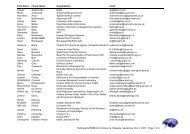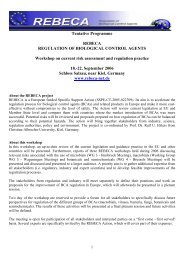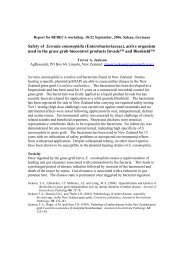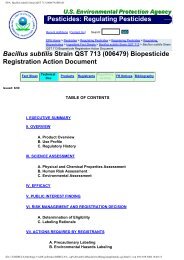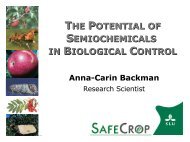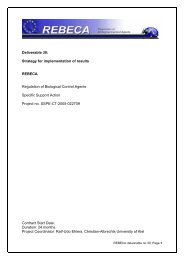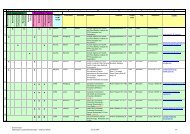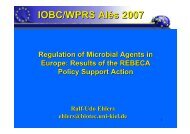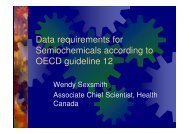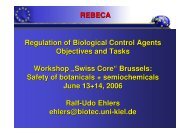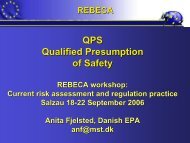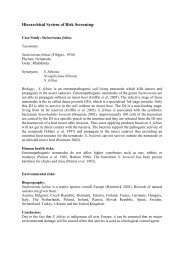Deliverable 28: Specification of low risk products REBECA ...
Deliverable 28: Specification of low risk products REBECA ...
Deliverable 28: Specification of low risk products REBECA ...
Create successful ePaper yourself
Turn your PDF publications into a flip-book with our unique Google optimized e-Paper software.
esulting from microbial pest control <strong>products</strong> are not necessarily determined by the<br />
same variables as those for conventional chemical pesticides.<br />
Norwegian Indicator (NARI)<br />
The Norwegian Agricultural Inspection service has established separate pesticide<br />
<strong>risk</strong> indicators to assess human health and environmental <strong>risk</strong> with the purpose <strong>of</strong><br />
tracking <strong>risk</strong> reduction over time. This was aimed to assist a government initiative,<br />
which had a declared goal <strong>of</strong> reducing pesticide <strong>risk</strong> by 25 % between 1998 and<br />
2002, and also encompassed the introduction <strong>of</strong> <strong>risk</strong> based taxes on pest control<br />
<strong>products</strong> (Norwegian Agricultural Inspection Service, 2002). Compared to <strong>risk</strong> indices<br />
implemented in other OECD countries (OECD, 2004b), the Norwegian model is a<br />
step towards a more integrated model that attempts to include both exposure and<br />
toxicity. For the calculation <strong>of</strong> the Norwegian environmental <strong>risk</strong> indicator, scores are<br />
assigned for (i) terrestrial adverse effects, (ii) aquatic adverse effects, (iii) leaching<br />
potential, (iv) persistence, and (v) bioaccumulation. Scores in the terrestrial and<br />
aquatic categories are calculated using both toxicity <strong>of</strong> and exposure to a substance;<br />
values are assigned in two different groups <strong>of</strong> organisms (bees/earthworms/birds and<br />
fish/aquatic invertebrates/plants, respectively), the highest value in each category is<br />
used for the calculation. Values for persistence, mobility and bioaccumulation are<br />
also assigned according to set intervals. The environmental <strong>risk</strong> indicator is then<br />
calculated as the squared sum <strong>of</strong> all components. Modifications <strong>of</strong> the indicator are<br />
possible, defined for specific scenarios such as seed treatments or greenhouse<br />
applications. Microbial pest control agents are routinely assigned a value <strong>of</strong> one<br />
(<strong>low</strong>est <strong>risk</strong>).<br />
The inclusion <strong>of</strong> exposure considerations, as well as the breakdown into separate<br />
environmental and health indices in the Norwegian model marks a significant<br />
advantage over the EIQ. Certainly, this al<strong>low</strong>s for a more differentiated assessment<br />
<strong>of</strong> pesticide <strong>risk</strong>s to humans and the environment. The advantage <strong>of</strong> the Norwegian<br />
system is that it is entirely based on data commonly requested by registration<br />
authorities, and as such data to calculate the <strong>risk</strong> score should be readily available,<br />
at least within governments.<br />
However, the Norwegian system also has some significant weaknesses. Most<br />
importantly, the indicator is simply a sum <strong>of</strong> its subcomponents, which is not<br />
reflective <strong>of</strong> interactions between the different components. For instance a high level<br />
<strong>of</strong> persistence, mobility or toxicity will each increase the <strong>risk</strong> posed to aquatic and<br />
terrestrial organisms. However, a very short half-life will significantly mitigate a high<br />
level <strong>of</strong> toxicity, whereas a highly persistent substance <strong>of</strong> the same toxicity will<br />
expose and possibly kill multiple times more non-target organisms.<br />
Another shortcoming <strong>of</strong> the Norwegian approach is the treatment <strong>of</strong> microbial pest<br />
control <strong>products</strong>. The simple flat-rate assignment <strong>of</strong> the minimal <strong>risk</strong> score to all<br />
microbial active ingredients may be a pragmatic approach useful in the context in<br />
which the Norwegian indicator is used but does not al<strong>low</strong> for a differentiated<br />
comparison between conventional chemicals and biological pesticides. For a<br />
regulatory comparative <strong>risk</strong> assessment or a farm level decision tool, a more<br />
sophisticated assessment <strong>of</strong> microbial pest control <strong>products</strong> is required.<br />
16



